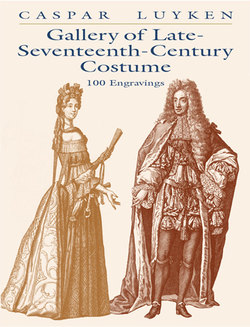Читать книгу Gallery of Late-Seventeenth-Century Costume - Caspar Luyken - Страница 4
Publisher’s Note
ОглавлениеIn 1703, Christoph Weigel of Nuremberg published the Neu-eröffnete Welt-Galleria, a collection of 100 costume plates etched by the Dutch artist Caspar Luyken (1672–1708). Luyken, the son of noted engraver and poet Jan Luyken, had arrived in Germany in 1699 to work with Weigel on a number of illustrated books.
The contents of the original title page [the frontispiece of this edition], can be summarized as follows: It announces the “recently opened world gallery,” which offers “curious and amusing attire of different walks of life from around the world”; the plates begin with depictions of members of the imperial court of Vienna, and proceed to other important individuals, finally presenting the “simplest common man”; the plates are said to have been “etched in copper” by Christoph Weigel in Nuremberg in 1703. The presenter of the collection, P. Abrahamo à S. Clara, was born Ulrich Megerle in Baden, ca. 1644. After attending Jesuit and Benedictine schools, he pursued a theological career and was appointed preacher to the imperial court at Vienna in 1677. A prolific writer of religious treatises, sermons, and verse, Sancta Clara was held in esteem by Friedrich Schiller, among other literary figures of the time.
The plates themselves reveal many fascinating details, in addition to their depiction of royalty, clergy, the military, and various national types. For instance, on Plates 41 and 42, a miniature version of adult costume is worn by children—the convention throughout much of history. Plate 73 shows a Cossack whose toes are revealed by a worn-out boot. A number of plates display Turkish dress—not surprising, as the Turks laid siege to Vienna in 1683; they were defeated by the Austrians, Germans, and Poles.
The present volume, Gallery of Late-Seventeenth-Century Costume, is a republication of the 100 costume plates from the Neu-eröffnete Welt-Galleria. The original captions appear in brackets below their translations into English on the costume plates. [The original list of illustrations has been omitted, as it duplicates the information on the plates; it did, however, indicate that the costumes represented a panorama from the “evening” lands [i.e. the West, or Europe] to the “morning” lands [the East—Asia, Africa, and America]. An English translation of Sancta Clara’s Dedication and Introduction has been provided in the front matter, followed by reproductions of the original German pages. The original title page of the 1703 edition is included here as the frontispiece.
